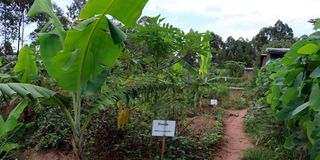Schools using permaculture to adapt to climate, enhance food security

A permaculture unit at St. Denis Libolina School in Bungoma.
What you need to know:
- The system is environmentally friendly, produces healthier organic foods, is self-sustaining, can rehabilitate land and develops systems that make humans and nature work together.
- It reduces energy and resource consumption and focuses on solutions rather than problems.
St Denis Libolina School for the physically challenged in Bungoma, Thika Rescue Centre in Kiambu, Buchenya Primary in Kakamega and Kimua Primary in Machakos are among more than 300 learning institutions in Kenya that have demonstrated how eco-friendly farming in schools can easily support sustainable food systems in the face of climate change.
On the outskirts of Myanga township in Bumula, students and teachers at St Denis Libolina have transformed any visible land, including spaces in front of classrooms and the primary school farm, into vegetable gardens and food forests. As a result, in the past one and a half years, the school has not spent a coin to buy vegetables for all the boarding pupils. Sometimes they even have surplus for the market.
"This project is a true transformation for us because apart from supporting the school feeding programme throughout the year, it is part of our students' practical lessons based on the Competency-Based Curriculum," said Gladys Orlando, the school head teacher.
The school is using a permaculture farming system to produce food ecologically, with knowledge and technical support from Regional Schools and Colleges Permaculture (ReSCOPE). The Permaculture Research Institute defines permaculture (permanent agriculture) as the conscious design and maintenance of agriculturally productive ecosystems that have the diversity, stability, and resilience of natural ecosystems. It is the harmonious integration of landscape and people, providing their food, energy, shelter and other material and non-material needs in a sustainable way.
The system is environmentally friendly, produces healthier organic foods, is self-sustaining, can rehabilitate land and develops systems that make humans and nature work together. It reduces energy and resource consumption and focuses on solutions rather than problems.
During the 28th round of climate negotiations at the UN Conference of Parties (COP 28) in Dubai last December, a declaration was made to embed sustainable agriculture, resilient food systems and climate action to pave the way for enhanced access to finance and scale up resilience efforts, thereby promoting global food security.
The Intergovernmental Panel on Climate Change report also underscores that effective solutions to mitigate and adapt to climate change in climate-resilient development and holistic measures, including in the food and agriculture sectors.
Studies have also found that hands-on training prepares students for their future careers in agriculture by giving them a glimpse of what to expect in the field.
At St Denis Libolina, the school has invested in water harvesting whenever it rains. Several trenches are dug on the school farm for harvesting rainfall runoff water. Cover crops have been planted all over and simple techniques such as mulching and composting ensure that crops have an eco-friendly environment for flourishing all year.
On the gardens, there are diverse crops, not limited to primarily indigenous vegetables, pulses, vine crops, fruit trees, bananas, tuber crops such as cassava, sweet potatoes and arrowroots, among other crops such as herbal plants like the lemon grass and hibiscus.
Karen Nekesa, the regional officer in charge of Advocacy at ReSCOPE, observes that with sustainable and ecological farming systems, school-owned land in many parts of the country can be used to supplement healthy school feeding programmes by 50 per cent, thereby conserving the environment as envisioned by the climate change negotiators at COP 28.
"It is a fact that public schools in this country, including those found in urban areas, have substantial land, most of which is underutilised. If well utilised, the land can be used for sustainable food production to the advantage of the learners," says Nekesa.
According to Bilha Miraba, a teacher and head of the farming club at Buchenya Primary School in Butere, Kakamega County, practical farming lessons at the school have attracted many people, including parents who come over to learn alongside their children.
According to Bilha, the only setback is the school's lack of resources to expand the project. "If we had sufficient resources, we would put up a dairy unit, a fish pond, an apiary and an indigenous poultry unit, among other things, because in permaculture, they are all interdependent on each other in a holistic way," she said.
According to the World Bank, only 10 per cent of global climate funds reach communities (such as schools in Kenya) directly, imposing constraints on national and local governments and communities in their efforts to transition toward green, resilient, and sustainable economies.





